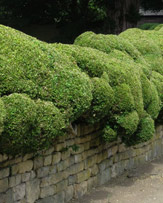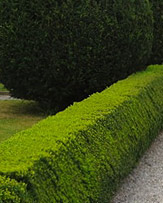Privet Hedges - Pruning Varieties and maintenance
Privet Hedges or ligustrum hedges are one of the easiest to care for prune and one of the most common forms of hedging available. Privet hedges are popular because they are easy to grow and maintain, provide a dense screen and generally privet hedges are an economical hedging solution.
Generally free from diseases we provide a general guide to privet hedges (Ligustrum). Basic privet hedge maintenance and pruning tips to help maintain a healthy hedge.
If you are looking for a hedge that will provide privacy then a Privet Hedge (Ligustrum) will do the job. Privet is dense growing, small leafed and is easily pruned to maintain shape. A number of Ligustrum (Privet) species are available for sale.
Pruning Privet Hedges
To maintain a privet hedge you need to trim it back every year. If the hedge begins to thin out and become 'spindly' remember that privet will respond well to cutting back fairly hard. Privet seems to like a little bonemeal once or twice a year to help maintain nice growth.
As privet flowers remember to trim the flowers and fruit to prevent spread by birds. Some people seem to have an allergy to the smell of privet when flowering, another reason to keep it trimmed.
Ligustrum ovalifolium 'Aureum' or 'Golden Privet' is a popular cultivar
Privet Varieties
Privet hedges are grown from a number of Ligustrum species including:
- Ligustrum lucid (glossy privet)
- Ligustrum japonicum (Japanese Privet or Wax-leaf Privet)
- Ligustrum japonicum 'Texanum' ( Waxleaf Ligustrum) a more compact and denser growth habit than the species
- Ligustrum amurense ( Amur Privet )
- Ligustrum vulgare (European privet, common or golden privet)
- Ligustrum sinense (Chinese Privet)
- Ligustrum ovalifolium (Oval-Leaved Privet)
Planting Privet Hedges
Prepare the ground by digging in some bone meal, plant privet at 3-4 plants per metre, water in well. Prune privet twice a year to create a dense screen.
Problems
In terms of diseases privet is fairly tough, rust and fungal diseases seem to be the only two problems.


